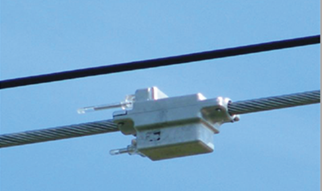Dynamic line rating
By taking into account local weather conditions, Dynamic Line Rating allows Elia to evaluate in real-time the maximum transmission capacity of the equipped lines.
Dynamic line rating (DLR) versus static line rating (SLR)
Static line rating, evaluated with deterministic or probabilistic methods, is based on certain rather conventional assumptions regarding atmospheric operating conditions. This approach has been widely accepted and used for decades, because different direct and indirect measurement techniques were unavailable or only used very rarely.
Over the past decade, one of the potential DLR options has drawn on a number of measurement and forecasting techniques. The data acquisition this entails is very often combined with meteorological measurements. By having both sources of information available, a line conductor model can be calibrated and subsequently used to work out variable transmission line limits, taking account of environmental cooling or heating as a major input factor.
This leads to the following definitions:
- Static thermal current: A static thermal current is a current that causes a conductor, operating under hypothetical atmospheric conditions and designed to operate continuously at a specified top temperature and a certain maximum sag, to reach either the maximum conductor temperature or its maximum sag.
- Dynamic thermal current: A dynamic thermal current is a current that causes a conductor, operating under real atmospheric conditions and designed to operate continuously at a specified top temperature and a certain maximum sag, to reach either the maximum conductor temperature or its maximum sag.
Elia has been working with Ampacimon since 2008 to develop and test a technology capable of calculating and forecasting the ampacity of overhead lines based on historical data, weather measurements and forecasts.
Ampacimon's technology uses small modules deployed on the most critical spans of a line. These modules continuously measure line sag, which allows Ampacimon to calculate the maximum permanent flows that the line is capable of supporting. The purpose of DLR is to safely optimise the use of existing line transmission capacity based on the real conditions under which power lines operate.

Use of DLR in the capacity calculation process
Using DLR in the process for calculating day-ahead and Intraday capacity means that, given the ambient temperature, wind speed and wind direction relating to a transmission line, the Imax of that line is dynamically determined based on DLR data that take account of these weather conditions within the limits of safe grid operation. The static seasonal limits are taken as the lower limit, so that applying DLR only has an increasing effect.
- 3.1 Basic principle
The basic principle for applying DLR to calculations of line capacity entails maximising the average capacity increase within the limits of a pre-defined increase in the risk to grid safety.
In an ideal scenario, a new method can be introduced without altering the risk to the grid's safe operation. However, since this is unrealistic, an acceptable increase in risk must be taken into account.
Using DLR increases the risk because the 1-hour forecast for every hour is not higher than the Forecast Horizon used to calculate capacity*. Consequently, the values from the Forecast Horizon cannot simply be carried over into the capacity calculation process, but have to be 'pre-treated'.
The method that, on average, results in the greatest increase (for the same risk increase) is a capping rule. Such a rule limits the value generated by the Forecast Horizon to a certain percentage related to seasonal limits.
(*) The increase in risk can be calculated as the percentage by which the Forecast Horizon exceeds the 1-hour forecast.
The pre-defined acceptable increase in risk is currently set at 0.1%, corresponding to roughly 9 hours a year.
Current roll-out
The table below shows the different Ampacimon modules and forecasting licences used by Elia.
| Line ID | Line Name | 1-hour forecast licence | Horizon licence |
| 150.41 | Baudour - Trivière | YES | - |
| 150.42 | Baudour - Trivière | YES | - |
| 380.32 | Gramme-Champion | YES | YES |
| 380.27 | Van Eyck-Maasbracht | YES | - |
| 380.19 | Achène-Lony | YES | YES |
| 380.25 | Doel-Zandvliet | YES | YES |
| 380.11 | Lixhe-Gramme | YES | - |
| 380.91 | Van Eyck-Lixhe | YES | YES |
| 380.12 | Van Eyck-Gramme | YES | YES |
| 380.28 | Van Eyck-Maasbracht | YES | YES |
| 380.31 | Gramme-Courcelles | YES | YES |
| 380.26 | Doel-Zandvliet | YES | YES |
| 380.10 | Achène-Gramme | YES | YES |
| 220.513 | Aubange-Moulaine | YES | YES |
| 220.514 | Aubange-Moulaine | YES | YES |
| 220.523 | Leval-Seraing | YES | - |
| 150.7 | Langerbrugge - Nieuwevaart | YES | - |
| 150.8 | Langerbrugge - Nieuwevaart | YES | - |
| 150.15 | Brugge-Slykens | YES | - |
| 150.16 | Brugge-Slykens | YES | - |
| 150.313 | Baudour-Chièvres | YES | - |
| 150.314 | Baudour-Chièvres | YES | - |
| 150.228 | Langerlo-Lixhe | YES | - |
| 150.229 | Langerlo-Lixhe | YES | - |
| 150.109 | Mol-Lomme | YES | - |
| 150.110 | Mole-Overpelt | YES | - |
| 150.140 | Eeklo Nord-Rodenhuize | YES | - |
| 150.141 | Eeklo Nord-Rodenhuize | YES | - |
| 70.49 | Moucron-Tournai | YES | - |
| 70.119 | Leuze - Marche-les-Dames | YES | - |
Definitions
-
Real-time (RT) ampacity:This is the permanent maximum ampacity of the line equipped with Ampacimon's modules (under unchanging weather conditions), with data updates every 5 minutes. This results in higher, but extremely volatile, Imax values, which makes these values less useful for the operational process.
-
1-hour forecast:This forecasts the maximum ampacity of the line equipped with Ampacimon modules for the next hour, with data updates every 5 minutes. The given Imax values are more stable than the RT ampacity and are therefore used to manage the transmission system in real time.
-
Forecast Horizon:This forecasts the maximum ampacity of the line equipped with Ampacimon modules for the next two days, with data updates every 6 hours. These values are primarily based on temperature forecasts. Again, the given Imax values are more stable than the RT ampacity and can therefore be used in capacity calculation methods.

